“The ’76 has that little extension on the tail, just forward of the taillights. It’s something they added for that model year.”
“What does it do?”
“It makes it longer.”
“I see.”
Down here in Spanish Banks, you can walk along the waterfront with the dogs and the bicycles and the kids, and watch the great big boats out there on the water. And, occasionally, on the road too.
Here we have a brace of road-going ocean liners from the 1970s, a decade well-known for restrained elegance and taste. Wait. I mean not known. Not known for elegance and taste. Not even a little bit. The cars were pretty cool, though.
The one on the left is a 1973 Eldorado convertible, and should you ever find yourself in a small plane with engine trouble, just aim for one of these and you can land safely on the hood. The one on the right is a 1976 Coupe de Ville, and you will be pleased to know that next-year’s Grey Cup will be held in its trunk. Also, a local developer will be building luxury condominiums on its front bumper starting in the spring. $600,000 and up. Reserve now.
In other words, these things are big. Huge. Enormous! Gargantuan! Collectively, they embody thirty feet and ten thousand pounds of solid Detroit steel, with doors as long as a Honda Civic and back seats large enough to raise livestock. Just getting into one is a hoot – the door clunks and creaks, the door-pull is long enough to be a leather belt for Dom DeLuise, and then you sink into plush seats that are so squashy it feels like somebody managed to upholster a Jello pudding. It’s amazing.
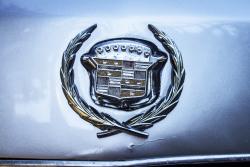 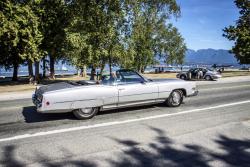 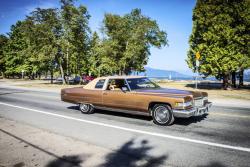 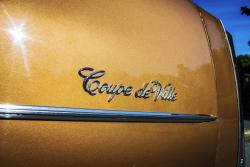 1973 Cadillac Eldorado Convertible, 1976 Cadillac Coupe de Ville. Click image to enlarge |
Both cars belong to Steve and Michael Gillis-Moore, a pair of car nuts who have a fleet consisting of a Miata, a Maxima, this brace of Caddies, and a Karmann Ghia that once belonged to Steve’s grandmother. Oh, and here’s the best part – Steve bought both of these machines for fifteen hundred bucks apiece.
Being a member of the Royal Vancouver Land Yacht Club isn’t an expensive option at all. “We don’t make new car payments,” Steve says, “So I’ve got money to play with on insurance.” The Cadillacs both get driven regularly, although the convertible doesn’t see much use once the sun stops shining.
The brown car was first to arrive, and its story isn’t one of long-time longing, or nostalgia, or a barn find, or an inherited relic. Instead, a Cadillac-loving friend in Arizona found the Coupe de Ville sitting for sale in Victoria and sent Steve an email: you should buy this.
When you’re spending fifty or fifteen thousand bucks, you do all your research and demand a pre-purchase inspection. When you’re spending fifteen hundred on the other hand, things are a little more relaxed. “I thought, sure, why not?” The only real obstacle was the ferry ride, but after the former owner sent over videos, photos, and documentation proving the de Ville’s bona fides, Steve took a day off and hopped on the boat to Victoria.
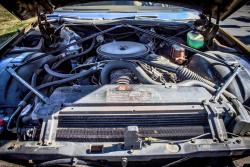 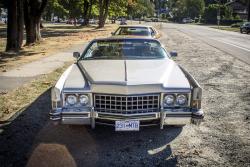 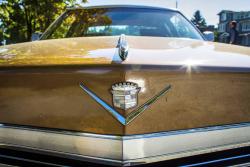 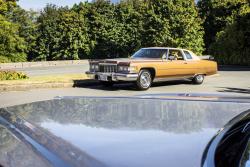 1976 Cadillac Coupe de Ville, 1976 Cadillac Coupe de Ville. Click image to enlarge |
“He met me at the terminal, and when I saw it, I figured there was no point even haggling over the asking price. I just paid for it and drove it home,” says Steve. I imagine he means sailed. Sailed it home.















